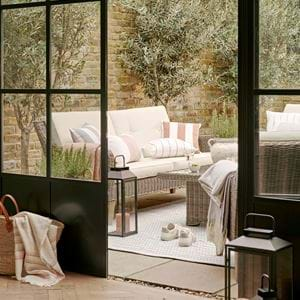A shed of one's own
A shed of one's own
Author and stylist Clare Nolan explains why a shed at the end of the garden is every grown up’s dream.
The humble garden shed – once seen as nothing more than a place to store the mower and left over paint or to fling the cushions from the outdoor chairs during the inevitable downpours of a British summer – is going through something of a rebirth.
With many of us now forced to play out all aspects of our lives within the boundaries of our plot, we’re looking at every corner of our homes through new eyes. No matter how big your home is, it can still feel too small. In the company of too many possessions and with additional family members working from home or home-schooling, space and the opportunity for time alone is too valuable to waste.
Many have looked to the garden to carve out the additional overflow space needed. Sales of garden buildings, whether custom architect-designed units or off the shelf summer houses and sheds, have risen dramatically these past twelve months. Many of us have repurposed and ‘pimped’ existing buildings, turning what was once merely a magnet to DIY and garden clutter into a garden bolthole; a room of one’s own.
Despite what we might be led to believe by trend pundits, this is not a new phenomenon – creatives have always been intent on carving out a space to be alone and purposeful. Why not a room with a view nestled in the undergrowth at the bottom of the garden? Dylan Thomas wrote many of his best-known works from his writing hut, perched on stilts on the cliff above the boathouse where he lived in Laugharne on the south coast of Carmarthenshire. Roald Dahl, inspired after a visit to the hut in the 1950s, decided to build his own to write in – he called this haven, where he dreamt up characters such as Willy Wonka, Mr Fox and the BFG, his ‘little nest’.
I was an early adopter to the shed movement – through necessity rather than by design. My first shed, a simple eight foot by six foot timber structure, came with our tiny cottage. Desperate for space, my husband and I overhauled the building – insulating then reboarding the walls and ceiling before painting inside and out. With the addition of a small heater, it became a year-round workspace.
It was my sanctuary, a place to contemplate and be creative – a grown up’s version of the Wendy house I never had. I wrote much of my first book in there and, when we had parties, it was the perfect place to peel off with a friend for a private chat. The space worked so well for me that, when we moved to our current house, a ‘shed’ was at the top of my lust-list. This time, starting from scratch, I upped the ante and commissioned a local contractor to build a ‘super shed’ to my own design.
It’s a space that allows freedom – in every sense. It’s where I can work away from the house and without distraction, but it’s also a space where I have the scope to experiment in terms of décor, to try out new ideas that might not be quite right for the house. It bridges the gap between indoor and out – a space where garden meets interior. But most of all, it gives me the freedom of time, of space – such valuable commodities – and, with that, anything is possible.
Clare Nolan is a stylist, photographer and author, and runs styling and photography workshops. clarenolan.com @clarenolanuk









